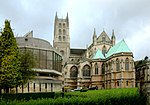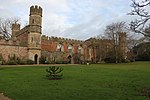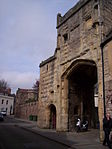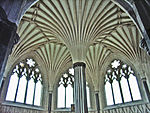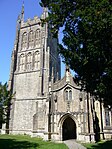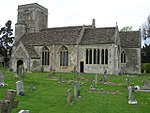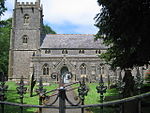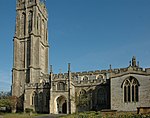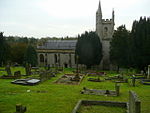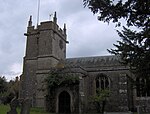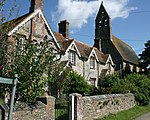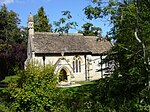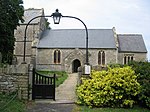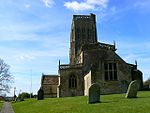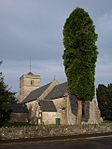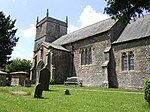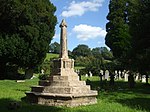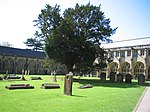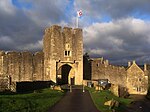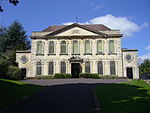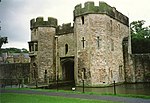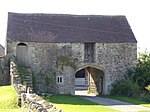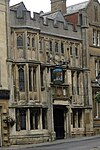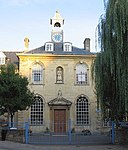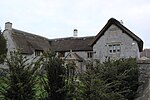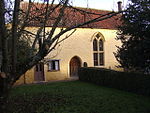Grade_I_listed_buildings_in_Mendip
Mendip is a local government district in the English county of Somerset. The Mendip district covers a largely rural area of 285 square miles (738 km2)[1] ranging from the Mendip Hills through on to the Somerset Levels. It has a population of approximately 11,000.[1] The administrative centre of the district is Shepton Mallet.
In the United Kingdom, the term listed building refers to a building or other structure officially designated as being of special architectural, historical or cultural significance; Grade I structures are those considered to be "buildings of exceptional interest".[2] Listing was begun by a provision in the Town and Country Planning Act 1947. Once listed, severe restrictions are imposed on the modifications allowed to a building's structure or its fittings. In England, the authority for listing under the Planning (Listed Buildings and Conservation Areas) Act 1990[3] rests with Historic England, a non-departmental public body sponsored by the Department for Digital, Culture, Media and Sport; local authorities have a responsibility to regulate and enforce the planning regulations.
There are 90 Grade I listed buildings in Mendip. Most are Norman- or medieval-era churches, many of which are included in the Somerset towers, a collection of distinctive, mostly spireless Gothic church towers. The greatest concentrations of Grade I listed buildings are in Wells and Glastonbury. In Wells these are clustered around the 10th-century Cathedral Church of St Andrew, better known as Wells Cathedral, and the 13th-century Bishop's Palace.[4] Glastonbury is the site of the Abbey, where construction started in the 7th century,[5] and its associated buildings. The ruined St Michael's church, damaged in an earthquake of 1275,[6] stands on Glastonbury Tor, where the site shows evidence of occupation from Neolithic times and the Dark Ages.[7] The Chalice Well has been in use since Pre-Christian times.[8] Glastonbury Abbey had a wider influence outside the town: tithe barns were built at Pilton[9] and West Bradley[10] to hold tithes, and a Fish House[11] was built at Meare along with a summer residence for the Abbot (now Manor Farmhouse[12]).
Medieval structures include Farleigh Hungerford Castle, fortified around 1370, and The George Inn at Norton St Philip, used as an army headquarters during the Monmouth Rebellion in 1685, and then as a courtroom to try the rebels in the Bloody Assizes.[13] Manor houses such as the 15th-century Seymours Court Farmhouse[14] at Beckington and The Old Manor at Croscombe. Mells Manor followed in the 16th century and in the 17th century Southill House[15] in Cranmore was built. Ston Easton Park[16] and Ammerdown House[17] in Kilmersdon were both completed in the 18th century. The most recent buildings included in the list are churches: the Church of St Peter at Hornblotton, built in 1872–74 by Sir Thomas Graham Jackson to replace a medieval church on the same site,[18] and Downside Abbey at Stratton-on-the-Fosse, more formally known as "The Basilica of St Gregory the Great at Downside", a Roman Catholic Benedictine monastery and the Senior House of the English Benedictine Congregation. The current buildings were started in the 19th century and are still unfinished.[19]
Download coordinates as:
- The date given is the date used by Historic England as significant for the initial building or that of an important part in the structure's description.
- Sometimes known as OSGB36, the grid reference is based on the British national grid reference system used by the Ordnance Survey.
- The "List Entry Number" is a unique number assigned to each listed building and scheduled monument by Historic England.
- "A Portrait of Mendip". Mendip District Council. Retrieved 21 October 2017.
- "Listed Buildings". Historic England. Retrieved 23 August 2017.
- "Planning (Listed Buildings and Conservation Areas) Act 1990 (c. 9)". Ministry of Justice. Archived from the original on 18 April 2010. Retrieved 17 December 2007.
- Historic England. "The Bishop's Palace and Bishop's House (1382873)". National Heritage List for England. Retrieved 7 July 2015.
- Historic England. "Glastonbury Abbey (1345447)". National Heritage List for England. Retrieved 3 April 2015.
- "Historical Earthquake Listing". British Geological Survey. Archived from the original on 19 November 2007. Retrieved 25 December 2007.
- "The Glastonbury Tor Maze". About Glastonbury Tor. Retrieved 25 December 2007.
- Historic England. "The Chalice Well (1167594)". National Heritage List for England. Retrieved 3 April 2015.
- Historic England. "Former Tithe Barn in farmyard at Cumhill Farm (1058842)". National Heritage List for England. Retrieved 3 April 2015.
- Historic England. "Court Barn (1175792)". National Heritage List for England. Retrieved 3 April 2015.
- Historic England. "The Abbot's Fish House (1345067)". National Heritage List for England. Retrieved 7 July 2015.
- "History". The George Inn. Archived from the original on 29 August 2009. Retrieved 20 May 2009.
- Historic England. "Seymours Court Farmhouse (1058220)". National Heritage List for England. Retrieved 3 April 2015.
- Historic England. "The Old Manor (1174843)". National Heritage List for England. Retrieved 3 April 2015.
- Historic England. "Ston Easton Park (1345108)". National Heritage List for England. Retrieved 3 April 2015.
- Historic England. "Church of St Peter (1058789)". National Heritage List for England. Retrieved 3 April 2015.
- Historic England. "1 St Andrew Street (1383102)". National Heritage List for England. Retrieved 3 April 2015.
- Historic England. "1 – 13 Vicars Close (1383197)". National Heritage List for England. Retrieved 3 April 2015.
- Historic England. "14 – 27 Vicars Close (1383199)". National Heritage List for England. Retrieved 3 April 2015.
- Historic England. "Abbey Tithe Barn, including attached wall to east (1057953)". National Heritage List for England. Retrieved 3 April 2015.
- Historic England. "Abbot's Kitchen, Glastonbury Abbey (1172820)". National Heritage List for England. Retrieved 7 July 2015.
- Historic England. "Bishop Burnell's Great Hall (1382875)". National Heritage List for England. Retrieved 7 July 2015.
- Historic England. "Boundary Walls to 1 – 13 Vicars Close (1383198)". National Heritage List for England. Retrieved 3 April 2015.
- Historic England. "Boundary walls to 14 – 27 Vicars Close (1383200)". National Heritage List for England. Retrieved 3 April 2015.
- Historic England. "Brown's Gatehouse (1383101)". National Heritage List for England. Retrieved 7 July 2015.
- Historic England. "Chapter House to Cathedral of St Andrew (1382900)". National Heritage List for England. Retrieved 3 April 2015.
- Historic England. "Church of St Aldhelm (1217750)". National Heritage List for England. Retrieved 3 April 2015.
- Historic England. "Church of All Saints (1058488)". National Heritage List for England. Retrieved 3 April 2015.
- Historic England. "Church of All Saints (1174267)". National Heritage List for England. Retrieved 3 April 2015.
- Historic England. "Church of All Saints (1058297)". National Heritage List for England. Retrieved 3 April 2015.
- Historic England. "Church of St Andrew (1295876)". National Heritage List for England. Retrieved 3 April 2015.
- Historic England. "Church of St Bartholomew (1058528)". National Heritage List for England. Retrieved 3 April 2015.
- Historic England. "Church of St Benedict (1057966)". National Heritage List for England. Retrieved 3 April 2015.
- Historic England. "Church of St Cuthbert (1383111)". National Heritage List for England. Retrieved 3 April 2015.
- Historic England. "Church of St Dunstan (1345010)". National Heritage List for England. Retrieved 3 April 2015.
- Historic England. "Church of St George (1345317)". National Heritage List for England. Retrieved 3 April 2015.
- Historic England. "Church of St Giles (1058345)". National Heritage List for England. Retrieved 3 April 2015.
- Historic England. "Church of St James (1058471)". National Heritage List for England. Retrieved 3 April 2015.
- Historic England. "Church of St John the Baptist (1345459)". National Heritage List for England. Retrieved 3 April 2015.
- Historic England. "Church of St John the Baptist (1058818)". National Heritage List for England. Retrieved 3 April 2015.
- Historic England. "Church of St Lawrence (1177825)". National Heritage List for England. Retrieved 3 April 2015.
- Historic England. "Church of St Lawrence (1345357)". National Heritage List for England. Retrieved 3 April 2015.
- Historic England. "Church of St Leonard (1058276)". National Heritage List for England. Retrieved 3 April 2015.
- Historic England. "Church of St Leonard (1058592)". National Heritage List for England. Retrieved 3 April 2015.
- Historic England. "Church of St Margaret (1177624)". National Heritage List for England. Retrieved 3 April 2015.
- Historic England. "Church of St Mary (1058710)". National Heritage List for England. Retrieved 3 April 2015.
- Historic England. "Church of St Mary (1345127)". National Heritage List for England. Retrieved 3 April 2015.
- Historic England. "Church of St Mary (1058711)". National Heritage List for England. Retrieved 3 April 2015.
- Historic England. "Church of St Mary (1058750)". National Heritage List for England. Retrieved 3 April 2015.
- Historic England. "Church of St Mary (1058224)". National Heritage List for England. Retrieved 3 April 2015.
- Historic England. "Church of St Mary, causeway bridge and gates (1058142)". National Heritage List for England. Retrieved 3 April 2015.
- Historic England. "Church of St Mary Magdalene (1345137)". National Heritage List for England. Retrieved 3 April 2015.
- Historic England. "Church of St Mary Magdalene (1345167)". National Heritage List for England. Retrieved 3 April 2015.
- Historic England. "Church of St Mary Magdalene (1295880)". National Heritage List for England. Retrieved 3 April 2015.
- Historic England. "Church of St Mary the Virgin (1234822)". National Heritage List for England. Retrieved 3 April 2015.
- Historic England. "Church of St Mary the Virgin (1174682)". National Heritage List for England. Retrieved 3 April 2015.
- Historic England. "Church of St Matthew (1295105)". National Heritage List for England. Retrieved 3 April 2015.
- Historic England. "Church of St Michael (1345316)". National Heritage List for England. Retrieved 3 April 2015.
- Historic England. "Church of St Nicholas (1345049)". National Heritage List for England. Retrieved 3 April 2015.
- Historic England. "Church of St Peter (1059172)". National Heritage List for England. Retrieved 3 April 2015.
- Historic England. "Church of St Peter and St Paul (1307311)". National Heritage List for England. Retrieved 3 April 2015.
- Historic England. "Church of St Peter and St Paul (1345202)". National Heritage List for England. Retrieved 3 April 2015.
- Historic England. "Church of the Holy Trinity (1058753)". National Heritage List for England. Retrieved 3 April 2015.
- Historic England. "Church of the Holy Trinity (1345303)". National Heritage List for England. Retrieved 3 April 2015.
- Historic England. "Church of St Vigor (1345110)". National Heritage List for England. Retrieved 3 April 2015.
- Historic England. "Cloisters to Cathedral Church of St Andrew (1382902)". National Heritage List for England. Retrieved 3 April 2015.
- Historic England. "Farleigh Hungerford Castle (1058117)". National Heritage List for England. Retrieved 3 April 2015.
- Historic England. "Former Rook Lane Congregational Chapel (1167729)". National Heritage List for England. Retrieved 3 April 2015.
- Historic England. "Gatehouse and boundary wall with bridge over moat (1382876)". National Heritage List for England. Retrieved 3 April 2015.
- Historic England. "Gatehouse to west of Manor Farmhouse (1175158)". National Heritage List for England. Retrieved 3 April 2015.
- Historic England. "George Hotel and Pilgrims' Inn (1345455)". National Heritage List for England. Retrieved 7 July 2015.
- Historic England. "Mells Manor and garden walls to rear (1058351)". National Heritage List for England. Retrieved 3 April 2015.
- Historic England. "Penniless Porch (1383024)". National Heritage List for England. Retrieved 3 April 2015.
- Historic England. "Southill House and outbuildings (1058567)". National Heritage List for England. Retrieved 3 April 2015.
- Historic England. "St Michaels church tower, Tor Hill (1345475)". National Heritage List for England. Retrieved 3 April 2015.
- Historic England. "The Bishop's Barn (1383158)". National Heritage List for England. Retrieved 7 July 2015.
- Historic England. "The Bishop's Chapel and the Bishop's Palace (1382874)". National Heritage List for England. Retrieved 7 July 2015.
- Historic England. "The Bishop's Eye (1383026)". National Heritage List for England. Retrieved 7 July 2015.
- Historic England. "The Blue House (1345500)". National Heritage List for England. Retrieved 3 April 2015.
- Historic England. "The chain gate with approach staircase (1382904)". National Heritage List for England. Retrieved 3 April 2015.
- Historic England. "The Gatehouse (1345035)". National Heritage List for England. Retrieved 3 April 2015.
- Historic England. "The George Inn (1174953)". National Heritage List for England. Retrieved 3 April 2015.
- Historic England. "The Old Deanery (1382906)". National Heritage List for England. Retrieved 3 April 2015.
- Historic England. "Old Deanery Court with link wall along east side (1382907)". National Heritage List for England. Retrieved 3 April 2015.
- Historic England. "The Tribunal (1345457)". National Heritage List for England. Retrieved 3 April 2015.
- Historic England. "The Vicars' Chapel (1383201)". National Heritage List for England. Retrieved 7 July 2015.
- Historic England. "The Vicars' Hall including number 28 (1383202)". National Heritage List for England. Retrieved 7 July 2015.
- Historic England. "Tithe Barn in farmyard at Manor Farm (1221353)". National Heritage List for England. Retrieved 3 April 2015.



